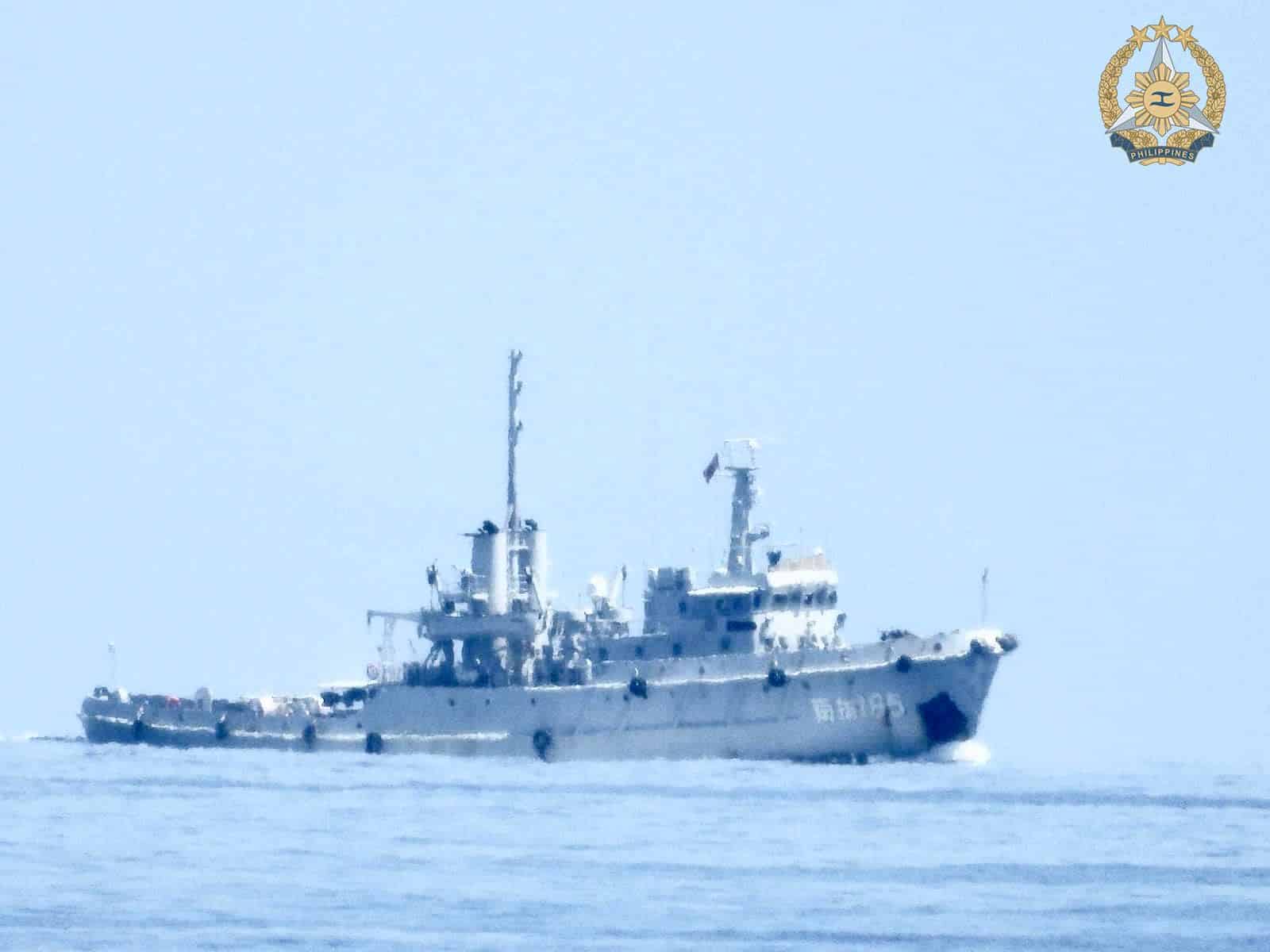Chinese tugboat seen near BRP Sierra Madre; PH Navy dismisses towing

A Chinese Navy tugboat is spotted about five nautical miles away from BRP Sierra Madre in Ayungin Shoal in the West Philippine Sea. PHOTO FROM THE PHILIPPINE NAVY
MANILA, Philippines — A Chinese tugboat was spotted near the BRP Sierra Madre in Ayungin (Second Thomas) Shoal, but a Philippine Navy official on Tuesday downplayed fears that the grounded naval outpost might be towed away.
Rear Admiral Roy Vincent Trinidad, Navy spokesperson for the West Philippine Sea, said the People’s Liberation Army-Navy (PLA-N) tugboat was sighted on Monday five nautical miles south of BRP Sierra Madre (LS-57).
Trinidad dismissed the possibility that the deployment of a tugboat indicates that China is now moving towards towing the World War II-era warship.
“It will take more than a tugboat to tow BRP Sierra Madre,” Trinidad said in a regular AFP press briefing.
READ: Teodoro: Heightened Chinese activities in Ayungin no threat to PH troops
He said the BRP Sierra Madre is “strongly anchored” to the corals off the shoal.
“Our assessment is that this is more for their own use in the event that they would need a tugboat to pull out any of their ships that would run aground in the shallow portion of Ayungin Shoal,” Trinidad said.
Trinidad said that Navy troops will not allow the Chinese Navy to do such a thing, saying there are contingency measures under their rules of engagement in anticipation of such moves against the warship that was deliberately aground there since 1999.
Trinidad also said that the morale of troops in the BRP Sierra Madre remains high.
“Our men have been aboard the BRP Sierra Madre for a quarter of a century, for 26 years now,” he said. “They are used to it.”
“The men there are veterans of the Mindanao campaign; they are used to hard life.
Tugging to test US treaty limits
Furthermore, maritime expert and SeaLight director Ray Powell recognized the “concern” that the Chinese Navy deployed the tugboat “with the intent of forcibly removing the BRP Sierra Madre.”
Powell noted that any direct action against the naval outpost “would certainly test the limits” of the “armed attack” provisions of the Mutual Defense Treaty (MDT) of Manila and Washington.
“We should hope it is only coercive messaging, but it bears very close watching,” Powell, program head of Stanford University’s Gordian Knot Center for National Security Innovation, told Inquirer.
Security expert Chester Cabalza also said BRP Sierra Madre’s towing will be a litmus test of the MDT, noting that the US would have to “re-assert their major role” in the Indo-Pacific region.
“It will definitely test the limits of MDT or how serious the US wants to protect the West Philippine Sea as an ally,” Cabalza, Cabalza, president and founder of the Manila-based think tank International Development and Security Cooperation, said in a message to Inquirer.
Act of war
Cabalza also said that towing the Sierra Madre would constitute an act of war, as the ship remains commissioned under the Philippine Navy.
“If that happens, it only means one thing: China now wants to invade the Philippines,” Cabalza also said.
“It is like burning our own embassy at sea that would lead to greater legal, geopolitical, and security consequences,” he continued. “That is brutally considered [as] an act of war.”
More Chinese ships at Ayungin
Aside from the tugboat, Trinidad said there were 13 maritime militia, and two China coast guard vessels spotted off the shoal’s vicinity on Monday.
This is still quite high from the “average” of seven militia vessels and two CCG vessels typically seen in Ayungin, according to Trinidad.
However, Monday’s count is still lower than recorded last Aug. 20, when 25 Chinese assets were monitored there.
There were five CCG vessels in the area supported by 11 rigid hull inflatable boats and fast boats, as well as nine militia vessels and a rotary helicopter.
READ: Armed boats, water cannons seen in latest show of China aggression in Ayungin
Rore a ‘moral obligation’
The maritime missions for BRP Sierra Madre has been one of the flashpoints in tensions in the West Philippine Sea, in line with Beijing’s sovereignty claim in almost the entire South China Sea already invalidated by a 2016 Arbitral Award while ruling heavily in favor of Manila’s sovereign rights.
The June 17, 2024 rotation and resupply (Rore) mission there last year saw the most violent confrontation by Manila and Beijing which led to serious injury of a Philippine Navy personnel.
The National Maritime Council said the last Rore was conducted in June.
AFP chief General Romeo Brawner Jr. on Sunday said the military is now preparing for another Rore for BRP Sierra Madre, which was echoed by Trinidad.
“The rotation and reprovisioning of our forces is a moral obligation of the leadership of the Armed Forces, regardless of any threat, any coercive aggressive action, it will be conducted,” Trinidad said. /jpv/abc/mcm
For comprehensive coverage, in-depth analysis, visit our special page for West Philippine Sea updates. Stay informed with articles, videos, and expert opinions.


















